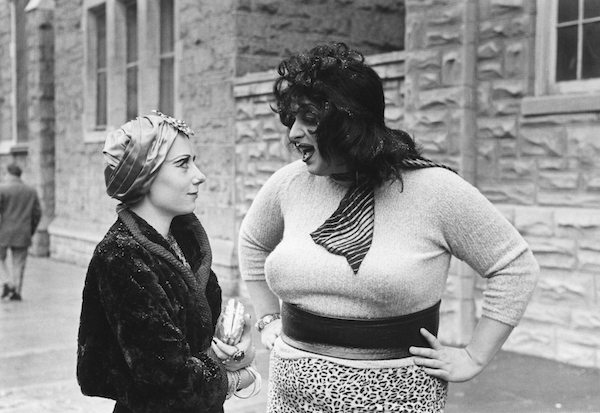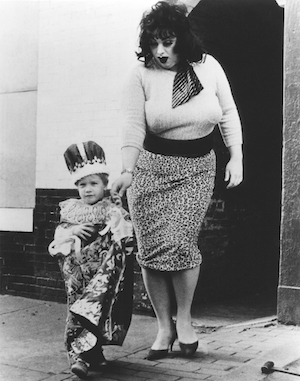
BY SCOTT STIFFLER | It’s turning out to be a very good summer for widely misunderstood women hell-bent on slaying the competition. Last Thursday, Hillary Clinton rose above decades of slander and scrutiny to accept the Democratic nomination. This Friday, the criminally insane Lady Divine returns to the silver screen in pristine condition, after slowly deteriorating for the better part of 50 years while tucked away in the home of delightfully transgressive cinematic trash merchant John Waters.
Shot in his native Baltimore, edited in his attic using a hot splicer and glue, and released in 1970 to the delight of proto-punks and the dismay of respectable society, “Multiple Maniacs” is a campy, often cutting, take on peace and love platitudes, religious ecstasy, social turmoil, and good old-fashioned romantic betrayal — expressed through graphic, often gleeful, acts of robbery, rape, murder, and cannibalism.
“It developed because of the ’60s,” Waters said of his second feature film. “There was a war going on. It was us against them. The Black Panthers and the Weathermen were in the news. Bombings were not at all uncommon. There were skyjackings. Nixon [Watergate] came later — but Woodstock, Altamont, that all happened while we were making the film. It was a volatile time.” As for the counterculture (San Francisco and Provincetown were influential ports of call for many cast and crew members), “We lived in the hippie world, but we made fun of it at the same time.”
The last film Waters would ever shoot in black and white, his use of that stock — along with the presence of objects, clothes, and cars that belong to a century we no longer live in — gives the modern day screening of “Maniacs” a vibe every bit as compelling and slightly off-putting as the deeply invested performances, which were as much a product of budgetary concerns as natural born quirks and charisma.

“We had rehearsals, a lot, in my apartment,” Waters recalled, noting the film has many scenes written as “long takes, so if you didn’t make a mistake, I didn’t do it again. Three or four times, they made a mistake and I thought, ‘I can live with it.’ There was no digital. This was real 16-millimeter film you had to take to the lab and get developed. It was expensive.” Furthermore, the director quipped, “A performance that is supposed to be funny doesn’t get any better the more times you do it.”
The ensemble includes longtime friends of Waters (Divine, Mink Stole) alongside new discoveries (Cookie Mueller, Edith Massey) — all of whom would further refine the signature Dreamland Studios tone in 1972’s “Pink Flamingos” and 1974’s “Female Trouble.” Few, however, would live to appear in his work after 1981’s “Polyester” (distinguished by its casting of matinee idol Tab Hunter, and the “Odorama” scratch and sniff cards distributed upon admission). Divine, who passed away less than two weeks after the release of 1988’s box office hit “Hairspray,” was the last of the original “Dreamlanders” to star in a Waters film. Johnny Depp, Kathleen Turner, Edward Furlong, Melanie Griffith, and Tracey Ullman had top billing in five subsequent releases, ending with 2004’s “A Dirty Shame.”
Nicely scrubbed up by Janus Films and scheduled to open nationwide on August 5, George S. Clinton contributed music to the restored version of “Maniacs.” “He did the soundtrack of ‘A Dirty Shame,’ ” Waters noted, “so I knew he would understand it. Some of it is original [new] music, some was made to sound alike, and some of it is a different version of the exact same music.” Of the surf and rockabilly sound (prominent in all of Waters’ early work, and culled from his extensive collection of vinyl), he noted, “That was the kind of music I liked growing up. I went to real theaters, where those movies were playing, so I have that kind of music in all of my movies. I was just a record guy.”
Back to 1970: “Multiple Maniacs” begins with Mr. David (David Lochary) using his one-of-a-kind, clipped carnival barker delivery to lure passersby into a tent (“This is the show you want. Lady Divine’s Cavalcade of Perversion, the sleaziest show on earth… real actual filth who have been carefully screened in order to present to you the most flagrant violation of natural law known to man.”). Cavalcade acts include a puke eater, a heroin addict going cold turkey, and, Mr. David points out, “two actual queers kissing each other like lovers on the lips.” In the show’s ritualistic climax, Lady Divine holds curious onlookers at gunpoint and demands their “wallets, jewelry, handbags, any fur items, all loose change, and any narcotics you may be carrying.” When a victim’s backtalk pushes her to the breaking point (not the last time this will happen), she adds murder to her list of crimes.

After a gossipy barmaid (the endearing Massey) phones Lady Divine to report the infidelity of her longtime lover, Mr. David (who’s involved with Mary Vivian Pearce’s Bonnie, a desperate Cavalcade wannabe), the rest of “Maniacs” plays out as a violent, sexually charged road trip, albeit conducted entirely within the Baltimore city limits — during which Lady Divine is violated by a glue-sniffing duo, has an encounter with the Infant of Prague, stumbles onto a Catholic church and receives criminal instructions by way of a religious vision, converts to lesbianism after Mink (Stole) gives her a “rosary job” (ask Google if you’ve never heard), suffers a multitude of other indignities, declares herself a “maniac,” and is ultimately taken out by the National Guard.
“It was a monster movie,” Waters declared, “and the monster always has to die in the end. I mean, look at Divine. She’s a monster; a big, lumbering idiot.” She’s also a killer — as are other Cavalcade denizens whose short fuses help to increase the body count.
“Yes, they’re murderers,” Waters readily admitted, “but Divine was out of her mind.” The final straw: Lobstora, a 15-foot crustacean, pins her down on the couch and has his way with her. Wait. What?
“It makes perfect sense,” Waters reasoned. “Don’t you think Divine is going crazy at that point? Is it a hallucination? Is it real? It pushes her over the edge. She is having a mental breakdown. She had a tough day. She got a rosary job, raped by a lobster. A lot happened.”
Reaction to the film was swift and decisive. “Horrendous. Sickening. Revolting. Most distasteful. The court’s eyes were assaulted,” wrote Baltimore Circuit Court Judge Joseph H. H. Kaplan, who declared the work “obnoxious but not legally obscene.” One member of the Maryland State Board of Censors was brought to tears after a screening; and when Waters attempted to retrieve a print seized by the Ontario Board of Censors, the only thing that arrived in the mail was a one-word note: “Destroyed.” Feedback from the mainstream press, which either didn’t get the joke or didn’t like it, was similarly unkind.
“Critics would rise to the bait,” Waters noted of his output from this era, “and give us horrendous reviews.” It’s no wonder. At the time, he recalled, “Everything was taboo. ‘Straight people’ meant they didn’t smoke pot. People went to exploitation movies because they wanted to see weird behavior, but they didn’t want to be around it.”
Nearly a half-century after the first run of “Multiple Maniacs,” far more heinous examples of the bad behavior and gratuitous nudity found in Lady Divine’s Cavalcade tent are only a click or a swipe away. And while downloadable pictures and video clips certainly have the power to entice and titillate, those weaned on such grab-and-go fare are likely to experience familiar stirrings from disturbing new sources, after spending 96 minutes immersed in Waters’ world.
“Religion, I think, will still be the shocking thing,” he said, referencing sex acts and drug use filmed in a real Catholic church. “It still has a kick to it, even to me. I thought, ‘God, what was I thinking about?’ ” Partial insight is provided by a comment made as Waters exited a recent Provincetown International Film Festival screening of what he once dubbed his “celluloid atrocity.”
“Somebody said to me, ‘The LSD must have been pretty good back then,’ which he was correct about.”
Produced, directed, written, filmed, and edited by John Waters. Opens Fri., Aug. 5 at IFC Center (323 Sixth Ave., at W. Third St.). Daily screenings at Daily screenings at 12:40pm, 7:10pm & 9:40pm. Visit ifccenter.com and janusfilms.com.

















